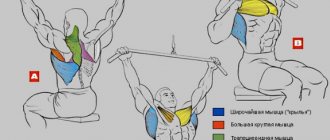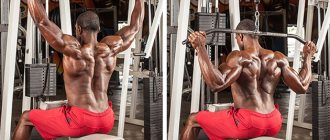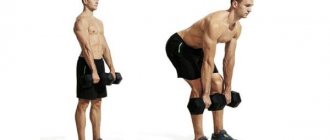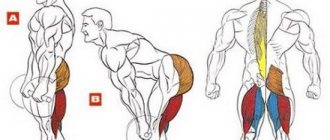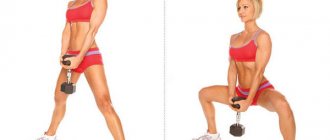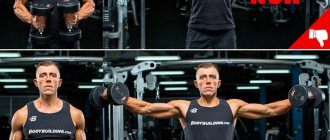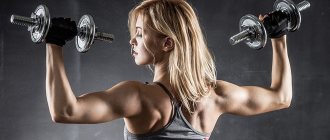The technique is performed only in the gym on a special simulator
The overhead pull-down is suitable for expanding the size of the torso due to the growth (hypertrophy) of the latissimus muscles. Simulates standard pull-ups, as it works a large number of muscles. However, it has its advantages compared to pull-ups.
On the simulator, you can adjust the weight and exercise in a descending pattern, even for beginners, that is, gradually increase the load. This allows you to make a larger range of motion and, accordingly, better work out the torso.
Advantages:
- Increasing the width of the back.
- V-shaped torso and thin waist.
- Smooth posture.
- Muscular and sculpted torso.
- Availability and ease of implementation.
- Suitable for those who cannot do pull-ups.
- Suitable for beginners.
- Suitable for men and women.
Unlike the front row, which targets the rhomboids and increases their thickness, the overhead row increases the width of the muscles.
Reverse-grip vertical pull-down to chest
This exercise uses the latissimus dorsi muscles to a greater extent. The biceps and forearms receive significant load.
Since the biceps and forearms are the weak link in this chain, they will tire before your back does, so using wrist straps is a good solution.
As a rule, they are sold in any sporting goods store.
They allow you to turn off your forearms and concentrate on working your back muscles.
The trick is that in this form of the exercise you need to try to grab the handle a little narrower, so the lats will receive a greater load. Experiment with the grip width and choose the most comfortable option for you.
Otherwise, the technique of performing the exercise will not change.
We remember about the position of the cable, the deflection in the lower back, the width of the grip, and the tight pressing of the upper thighs against the rollers.
How to start classes correctly
It is recommended to perform the exercises in the first part of the workout in the gym. To begin with, you need to choose the right weight (block weight) and number of repetitions. For this, it is better for beginners to contact an instructor.
Weight is determined by the level of physical fitness and the goals of the bodybuilder (to lose weight, build muscle mass, to “dry” the body). Beginners first need to work out the technique correctly, so it is better to start training with minimal weight.
It is necessary to start with 10 repetitions of 2 - 3 sets with weights of 25 - 30 kg for men and 15 - 20 kg for women . It is advisable for athletes with little experience to do 12 times for 4 approaches, for athletes with experience - 15 times for 4 approaches.
The main thing when performing an exercise is to adhere to the quality of the exercises, and not their quantity. To “dry”, gradually increase the weight or number of repetitions.

Before each session, be sure to do a warm-up (cardio exercise on an exercise bike, squats, bends, exercises with dumbbells) to warm up your muscles and prepare them for a safe and effective workout. At the end of the session, you need to relax the working muscles by stretching.
Before training, it is recommended to drink a glass of water (green tea), and during training, drink a little every 15-20 minutes. To increase muscle mass, you need to eat protein (powdered protein drinks, lean poultry or fish, egg whites) and carbohydrate foods (rice, oatmeal, wholemeal bread, freshly squeezed fruit juices diluted with water) in the first 20 minutes after training.
Almost eliminate fat from the diet. It is not recommended to eat food 1-2 hours before training.
Recommendations from professionals
- the weight should be pulled with your back, not with your hands;
- it is necessary to ensure that the handle is in a strictly fixed position;
- You cannot “walk” your elbows up and move them to the sides;
- there is no need to tilt the body too much if the work is carried out with light weight;
- when working with heavy weights, use straps to make it easier to hold the bar;
- The bar bar must be pulled as close as possible and strictly to the top of the pectoral muscles;
- looking down and tilting your head is strictly prohibited;
- select the weight so that there are no jerks;
- you can’t slouch;
- at the lowest point, pause for 1-2 seconds, tense your abs and legs, without lifting them from the clamp on the simulator.
Perform any of the exercises in 2, maximum 4 approaches. In this case, it is better to have 10-12 repetitions.
Classic lat pulldown
Main stages of correct execution:
- Correct placement in the machine. First, adjust the roller that secures the legs (knees) so that the weight does not pull the body upward. Place your hips tightly under the bolsters, and press your feet to the floor at knee level. Place the pelvis on the seat so that the upper block with the bar is above your head.

- Grab the handle of the bar with your hands. Having taken the correct position on the machine, as you exhale, pull the bar down, moving it behind your head. The narrower the grip, the more the biceps are worked (which in this case is not desirable), and the range of movements increases. On the contrary, as the grip increases, the load on the back increases and the amplitude decreases. It is optimal to choose a medium grip. There are scars on the handle on the right and left, you need to grab it so that your little finger is at the beginning of the scar - this is approximately an average grip. When bending your elbows at the lowest point at an angle of 90°, your forearms should be perpendicular to the floor and parallel to each other. The training cable is placed in a vertical position.
- When performing the exercise, fix your body exactly in a vertical position and do not slouch, tilt your head slightly forward, but look straight. In this case, the forearms move along the body, the shoulder blades are brought together. Pull the bar only by working your back muscles, not your arms! If during the movement the shoulders and forearms tense, and not the back (latissimus, rhomboid and lower trapezius muscles), then the execution is incorrect. If, despite the correct technique, the back is not being worked out, it is necessary to reduce the weight.
- You need to pull the bar until you lightly touch the back of your head. Then pause at the bottom point for a few seconds and straighten your elbows at the top point and inhale, but do not completely relax the shoulder girdle. You should not stretch your back and shoulders too much; this can lead to sprains and injuries. At the end of the workout, when the elbows are extended at the top point, take a series of inhalations and exhalations.
For a harmonious physique and athletic torso, it is recommended to systematically perform lat pulldowns 2-3 times a week.
Features of the technology:
- If, due to poor mobility of the shoulder joints, it is impossible to perform this exercise without slouching, it is better to abandon it.
- When moving your arms down, you need to lean forward slightly and bring your shoulder blades together.
- You need to pull the bar to the middle of the back of your head. To reduce excess load on the forearms, you can secure your hands to the bar with straps.
- Keep your head straight and look forward. The back is straight.
Recommendations for effective implementation
The technique of execution necessarily requires a clear sense of which part of the body bears the bulk of the load and is working at its maximum.
To perform “for results” you need to know:
- how to place your elbows correctly;
- how to work with your back;
- how to choose working weights;
- when to increase muscle contractions.
Working with your back
Sometimes the top block is performed incorrectly. That is, the main loaded pull is received by the biceps, and the rest of the weight is supplied by the latissimus muscles. In this case, the biceps get tired, and the pull-down does not strengthen or expand the back.

The upper row of the block is intended strictly for the comprehensive development of the spinal muscle groups! This is what the vertical row, performed with a wide grip, focuses on. Therefore, when the weight is pulled easily, it’s worth stopping for a split second and feeling how exactly the exercise is being done - biceps or “wings”.
How to place elbows
Rows performed while seated require different placement of the arms. The position of the elbows decides which parts of the back muscles work more. Elbows should not move back and forth. They need to be recorded. Shoulders should be at the same level.
During the exercise, the palms of your hands can be directed both towards you and away from you:
- biceps involvement increases significantly if the palm is facing towards you;
- The pectoral muscles actively work when using a parallel handle, when the palms are facing each other (seated chest pull).
Cheating
Most athletes doing shoulder exercises for their back risk straining or injuring ligaments by bringing down a heavy handle with their full weight. After all, rowing with a wide grip in a vertical block additionally engages the deltoid muscles. Their bundles must be warmed up before starting an intensive workout, that is, do a warm-up.
Without pre-warmed muscles, pulling to the chest from the upper block can have a detrimental effect on the health of the elbows and their joints. The “wings” are difficult to pull, but the shoulders are a mere trifle.
Selecting the working weight

The pull of a vertical block behind the head or to the chest is done while sitting, and implies the presence of additional weights. If jerky jerks occur during exercise, then you need to change the weight to a lighter one and check how accurately and comfortably the seat is installed. Then the block pull will be performed smoothly to the chest, without jolts.
Trainers recommend starting with light weight (from 2 kg). This approach will allow you to feel the back muscles and perform the exercise correctly 15-20 times.
We increase the quality of muscle contractions
A vertical row, for example, performed with one arm, uses one forearm and hand of that arm. To achieve better contraction without fatigue of the biceps and brachialis muscles, you need to use special loops (belts for hands). Similarly, you can neutralize the load on your arms and improve the quality of muscle contractions in your back by holding the handle with a reverse grip.
Complicated options and trajectories
The difference in grip of the handle distributes the load on different muscles.
There are three options for gripping the bar:
- straight (brushes turned away from you)
- reverse (the hands are turned towards you)
- parallel (the forearms are parallel and the hands are turned towards each other).
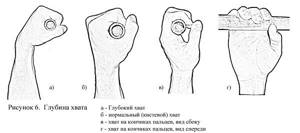
Straight-grip, wide-grip rows work the latissimus and teres major muscles while stretching ligaments and connective tissues. With a narrower grip, the load falls on the trapezius, biceps, lower part of the latissimus and posterior deltoid muscles. The close-grip row can be performed in a reverse or straight version.
When pulling a block with a reverse grip, the biceps are worked more. The parallel grip is a simplified version of the overhead pull-down and is best suited for beginners. If you have mastered and easily performed all the variations of exercises with the upper block, then you can move on to pull-ups on the bar.
Common mistakes

In a block simulator, vertical rows require maximum concentration and the correct sequence of actions.
Often, beginning athletes make the following group of mistakes:
- curvature, stooping of the vertebra;
- incorrect elbow position;
- the movement occurs with the buttocks lifting off the seat;
- when pulling the bar, the forearms are fully extended;
- the load is distributed on the biceps and other parts of the muscles, and not on the main body (back muscles);
- too much weight is taken, so the exercise becomes difficult to perform;
- vertical row, performed behind the head or with one hand, without warming up or preliminary preparation.
The above mistakes can be avoided if you approach your studies correctly. After all, there are no quick results!
Comprehensive muscle strengthening program
To effectively and efficiently work out all three groups of spinal muscles, overhead pull-downs are combined with other basic strength exercises:
- longitudinal press;
- bent over T-bar pull;
- lifting weights in a bent position with pauses;
- pulling dumbbells to the belt;
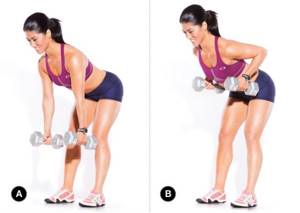
- pullovers;
- vertical lifting of weights with one hand;
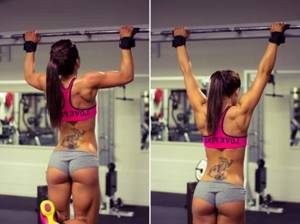
- Pull-ups on the bar.
It is not necessary to do all the exercises at once; it is enough to alternate several of them 2-3 times a week.
Female representatives, depending on their goals, can work both on strength indicators for the relief of the body, and on “drying” the upper back and shoulder girdle. Since girls find it difficult to do classic pull-ups on a bar, this exercise will help achieve a beautiful back shape.
What exercises should you do?
Let's divide shoulder exercises into three groups:
- bench presses;
- traction;
- flywheels
You can perform these shoulder exercises in any gym, fortunately there are a lot of variations and you need the simplest equipment.
Bench presses
Shoulder presses are basic exercises that work not only the deltoids, but also the triceps.
These are one of the main exercises in the arsenal of every mother's bodybuilder. There are as many of them as there are of your ex-girlfriends, only there are really a lot of exercises. Now I will list them according to my own priority. I'll start with the coolest ones, which will make your sculpted bones more meaty. Include them in your shoulder training program at the gym and you will be successful.
Seated dumbbell press
This exercise is done, as you might have guessed, with dumbbells and, most likely, you already realized that it is done while sitting. The essence of the exercise is that you sit on a bench in the gym, take dumbbells in your hands and begin to press them up above your head. Mainly the anterior and middle delta bundles work here.
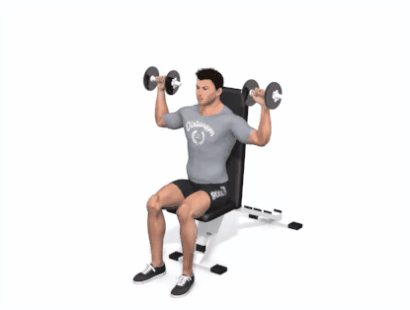
Bench press
In the Smith machine. For me personally, this exercise is more effective for pumping up deltoids, but it is more traumatic, so I decided not to give it first place. After all, if your shoulders are like Stephen Hawking’s, then it’s unlikely you’ll ever be able to make them bigger. In this exercise, you need to place a bench on a Smith machine and squeeze the bar from behind your head. You can do this exercise with a regular barbell, either standing or sitting. Again, mainly the anterior and middle delta bundles work here.
Hammer Seated Press
You won’t find such a device in basement rocking chairs, but in modern gyms there is plenty of such goodness. The beauty of this unit is that your birch branches, which you proudly call hands, will not sway from side to side if a fan is running nearby. This simulator has a clearly defined range of motion, from which it is simply impossible to deviate.

Standing barbell or dumbbell press
This exercise is even lower in my top list due to the fact that it works not only the deltoids, but also many other muscles that will take the load from the target muscle group. In addition, there is excessive stress on the spine. Again, we remember that health is more important and you are the only one with your mother, and there aren’t many guys with toned shoulders anyway, so you too will find your princess.
Standing Kettlebell Press
There are several execution options. For example, you can press one kettlebell with both hands, holding its base, or you can press one kettlebell in one hand, holding its handle. If we consider the first option, then instead of a weight you can use a disk. The essence will be the same.
This shoulder exercise is much less common in the gym than exercises with barbells and dumbbells. But that doesn't make it bad. Quite good exercises that, in addition, also strengthen the core muscles quite well.
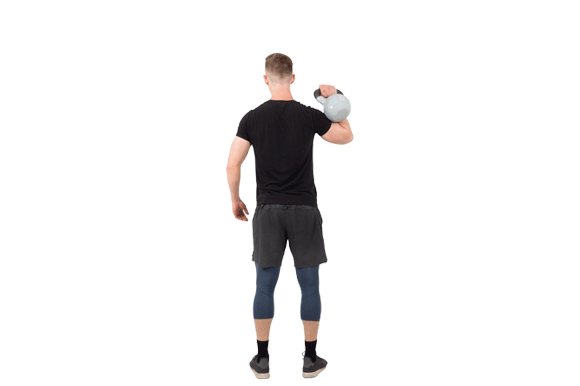
Traction
As for shoulder traction exercises, they are also basic and include, in addition to the deltoids, the biceps. There are fewer such exercises than bench presses, and they are done less often, but you shouldn’t put them in the closet. Let's go through the top list again.
Barbell row to the chin in the Smith machine
This exercise is good because, again, the amplitude is clearly defined and you won’t be swayed in all directions, like a herring in shallow water. You just approach the bar with the look of a winner, grab and squeeze the bar tightly and without unnecessary thoughts, and then simply pull your elbows up. The middle and anterior delta bundles are well worked out.
Barbell row to the chin (free weight)
This exercise can also make you the happy owner of real manly shoulders, the main thing is to perform it technically, and not as if you are being shocked with each repetition.

Kettlebell row to the chin
A similar exercise is the barbell row to the chin. The only difference is in the grip.
Handle pull in crossover to chin
This is a similar movement to all the others, but in this case it is performed in a block simulator. In essence, there is not much difference, but I like this shoulder exercise much less than the others.
Bent-over or bench dumbbell rows
This exercise is already aimed at the rear deltoids. You can do it either standing bent over or sitting, leaning on your knees, and you can also do this exercise while lying on a bench, which will eliminate the load on the spine.
As for me, performing this exercise with your chest resting on some surface is the most profitable option. There are also special hummer-type simulators that perform pulldowns on the rear deltoid. But not every hall has such delights, so don’t flatter yourself too much.
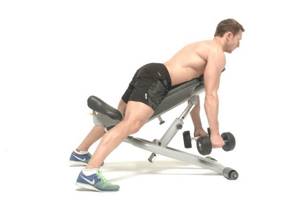
Fly feathers
Swing movements are isolating exercises and shift the emphasis to a specific delta beam depending on the direction of the swing.
Dumbbell lateral raises
This exercise works well on the middle deltoids. But the main thing is to do this exercise with the correct technique. One of the main shoulder exercises in the gym for men, you will see it as often as possible.
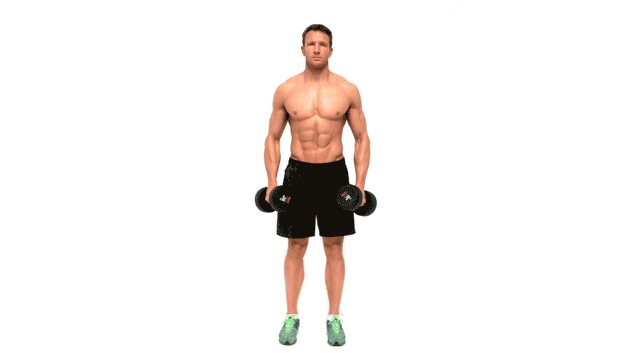
Raising dumbbells in front of you
You can perform this exercise with both hands at once or alternately. You can also do barbell and plate raises in front of you. These exercises primarily work the anterior deltoid.
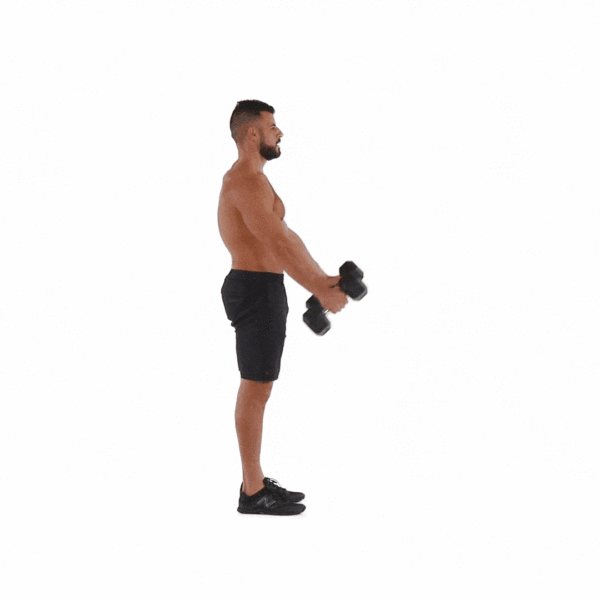
Swings with dumbbells tilted to the sides
This exercise can be done standing bent over, sitting on a bench or lying on a bench with emphasis on the chest. These exercises engage the posterior deltoids.
Pulling your arms back in the butterfly machine
This is a very good exercise for the rear delt. Similar to bent over swings, but much more convenient, which means it’s much easier to concentrate on the working muscle.
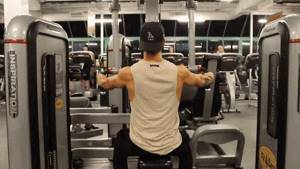
Swing the kettlebell in front of you
This is not a very standard exercise and it is basic. A huge number of muscles are involved in the work here. In addition to the shoulders, the back, buttocks and legs work well.

Swing with dumbbells or weights to full range
This is also not a completely standard exercise. Perform it like regular dumbbell lateral raises, but increase the amplitude and raise your arms above your head. It's a really good exercise for a change.
Swing movements in a crossover
In a crossover, you can perform all the same exercises as with dumbbells. The main difference is that with dumbbells the load decreases at the bottom and increases at the top, but with a crossover the load is always the same. You can do front lifts, side lifts, and bent over swings.

Now you know a huge variety of exercises that will help you build the shoulders of your dreams.
Knowledge is, of course, power, but simply knowing about these exercises and sitting on your phone the entire workout in the gym will not add strength to your fragile shoulders.
So get ready to work, and I’ll give you an example of shoulder training in the gym for men.
Basic rules for completing a workout
To prevent soreness caused by the accumulation of lactic acid in the muscles after exercise, you must adhere to the following recommendations:
- Every time before training, do a warm-up, and then stretch: standing straight, bend your chest forward, move your pelvis back. Bend your back at the thoracic region, then bend it back as far as possible. Bring your shoulders forward, stretch your arms forward and down. Move your chin following your hands. Stretch your arms as far as possible and return to the starting position. The tension should be felt in the area of the shoulder blades.
- End each workout with aerobic exercise (10 minutes on an exercise bike or treadmill).
- After each approach, take a break for 30 seconds.
Hammer Row
Hammer rows are recommended for people just starting to practice strength training. To minimize the risk of injury to an athlete, it is necessary to strictly follow the generally accepted algorithm for performing the exercise.
He is such a:
- Place the working weight in the block compartment of the simulator. Adjust the seat and the height of the handles to suit your height. Sit on a bench that is part of the structure. Place your hands on the handrails. Tighten your abdominal and back muscles as much as possible.
- As you exhale, bend your arms and pull the handles towards you. The elbows at this moment should “look” back. The position of the body remains unchanged.
- Hold the position for 3 seconds.
- Simultaneously with inhalation, straighten your arms.
Contraindications and restrictions for training
There are virtually no contraindications for overhead pull-downs, with the exception of:
- Hernia of the spine in the thoracic region.
- Injuries (sprains, dislocations, fractures) of the shoulder girdle, hands, elbows, back.
Don't miss the most popular article in the section: Morning exercises for those over 40, 50. Gymnastics exercises for weight loss, video lessons.
Advantages
Vertical traction in a simulator is included by fitness trainers in the vast majority of training programs they create due to a number of advantages of this type of load over its analogues.
They are:
- the ability to make the back wider, visually making the person’s figure more slim;
- improved posture;
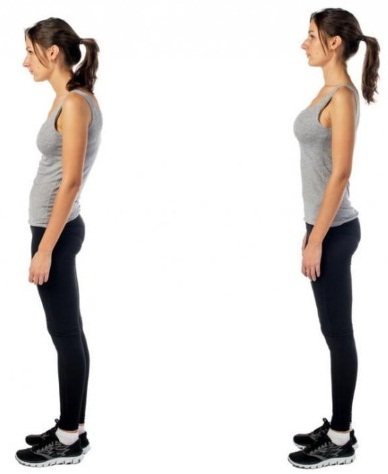
- the ability to rapidly increase the load without harm to the athlete’s health;
- strengthening the arm muscles, which subsequently accelerates the acquisition of the skill of performing other exercises, for example, pull-ups or push-ups;
- the ability to change the emphasis on the area being worked by introducing a number of traction variations in a block design into the training scheme;
- simplicity of the generally accepted algorithm for performing the exercise.
Basic errors during execution
Common mistakes:
- Stooping (curvature of the spine).
- Lifting the buttocks from the seat.
- Full extension of the forearms at the top point.
- Redistributing the load on the biceps of the arms, rather than the body.
- Too much weight or a large number of approaches, which will make it difficult to perform the exercise correctly.

If you don't straighten your back when performing overhead pull-downs, you may get injured.
Consequences of incorrect execution:
- injuries;
- pain in the body, resulting from the accumulation of lactic acid;
- ineffectiveness of working out the spinal muscles and hypertrophy of the arms, not the back.
To speed up the elimination of lactic acid after exercise, you can do a relaxing massage or take a warm bath.
Almost all bodybuilders include overhead pull-downs in their basic training routine. In addition, this simple strength exercise is widely used by beginners. The main thing in forming a beautiful figure is to adhere to systematicity and the correct technique.
Execution technique
To pump up your back muscles, you need to do lat pull-downs correctly. Each grip has its own characteristics.
However, one type or another begins with the preparation of the simulator.
To do this you need:
- select and install weights up to 15 kg (a large weight will lift the torso up, which should not happen);
- adjust the seat (your legs should fit snugly between the bolsters and the seat).
Narrow grip
Overhead rows work the biceps and to some extent the forearms.
The exercise technique includes 7 sequential actions:
- Stand up and with your hands, at a distance of 10 to 15 cm, take the handle.
- Sit down and feel the set weight by pulling the vertical block.
- Using the strength of the back muscles (without tension on the biceps), pull the elbow down until the bar is pulled to the bottom of the chin.
- Raise your head a little up so that it does not interfere with the moving weight and its trajectory.
- Pull the handle down (strictly vertically) to your neck, lowering the weight to your chest.
- Hold the weight for a few seconds.
- Return to original state.
The lat pulldown with a narrow grip is performed while sitting, without lifting the pelvic part of the body and tilting the back back.
Wide grip

Using a wide grip, pull the upper block towards the chest and behind the head. For both variations, as with the narrow grip, you must prepare the equipment.
A wide vertical (upper) row allows you to activate the work of the spinal muscles. At the same time, the biceps and muscle groups of the forearm, when performing a straight wide grip to the chest, are activated to a minimum.
How can you increase the quality of muscle contractions?
To increase the quality of muscle contractions when performing vertical rows, experienced fitness trainers recommend neutralizing the “intermediate” chain, which takes up part of the load. It consists of the biceps, muscles of the shoulder girdle and hands. You can eliminate the “leakage” by using wrist straps during the exercise.

The correct placement of the sports device will eliminate additional stress, making the work of the muscle corset longer and more focused.
